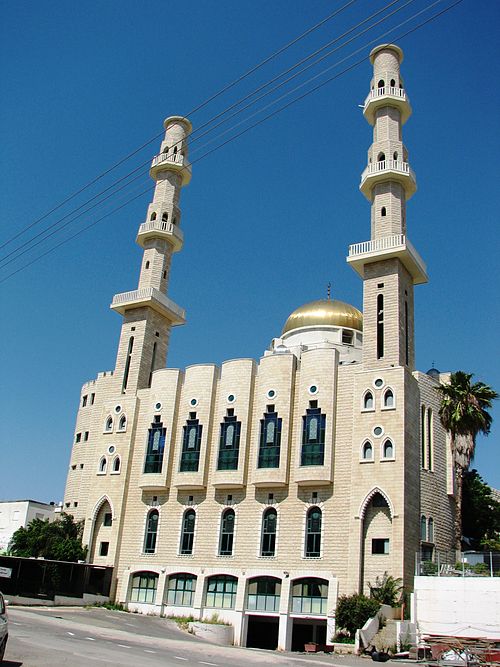Tur'an
| |
|---|---|
Local council (from 1959) | |
| Hebrew transcription(s) | |
| • ISO 259 | Ṭurˁan, Turˁan |
 Abu Baker Sadic Mosque, Tur'an, 2011 | |
| Coordinates:32°46′37″N35°22′33″E / 32.77694°N 35.37583°E /32.77694; 35.37583 | |
| Grid position | 185/242PAL |
| Country |  Israel Israel |
| District | Northern |
| Population (2023)[1] | |
• Total | 14,732 |
| Name meaning | Possibly from "an outlet of water", Syriac form[2] |
Tur'an (Arabic:طرعان,Hebrew:תֻּרְעָן) is anArablocal council in theNorthern District ofIsrael. It is located at the foot of Mount Tur'an and theTur'an Valley, near themain road fromHaifa toTiberias, and about 17 kilometres (11 mi) north ofNazareth.[3] In 2023 it had a population of 14,732, most of whom areIsraeli Arabs.[1]
Pottery and building remains from theIron Age I have been excavated in the northwestern part of the village. Apparently Tur'an was at that time (10–9th centuries BCE) surrounded by a city wall.[4] Apparently it was of a considerable size in the late tenth to the mid-ninth centuries BCE.[5] The massive wall, (width c. 2.4 m), probably enclosed an area of about 25 dunams, and has frm pottery remains been dated to Iron Age IIA (ninth century BCE).[6]
ThePEF'sSurvey of Western Palestine (SWP) found caves and rock-cutcisterns in the village, which they noted appeared to be an ancient site.[7]
The village was known in theRoman andByzantine periods (Mishnaic andTalmudic times, respectively) asTir'an. It was aJewish village.
Pottery from the early Islamic (7th century CE), andMamluk (14th century CE) have been excavated in the village centre, near the old mosque, together with building remains from the same period.[8]
In 1517, Tur'an was with the rest of Palestine incorporated into theOttoman Empire after it was captured from theMamluks, and by 1596, it appeared in the Ottomantax registers as being in thenahiya ofTabariyya, part ofSanjak Safad. It had a population of 48 households, allMuslim. They paid a fixed tax rate of 25% on agricultural products, including wheat, barley, olive trees, fruit trees, goats and/or beehives; a total of 5,410akçe.[9][10]
A map fromNapoleon's invasion of 1799 byPierre Jacotin showed the place, though misplaced, named asTouran.[11]
In 1838, it was noted as a large Muslim, Catholic Christian and Greek Christian village in the Nazareth district.[12][13]
In 1848,William F. Lynch described Tur'an as "quite a fortification."[14]The French explorerVictor Guérin visited Tur'an in 1870, and estimated it had 350 Muslims and 200 "Greeks".[15]In 1881, thePEF'sSurvey of Western Palestine (SWP) described it as "A stone village, partly built of basalt, containing about 300 inhabitants, half Christian, half Moslem.[..] The village is situated al the foot of the hills, and is surrounded by groves of olives. There is a good spring to the north-west."[16]
A population list from about 1887 showed thatTor'an had about 600 inhabitants; mixed Christians and Muslims.[17]
In the1922 census of Palestine conducted by theBritish Mandate authorities, Tur'an had a population of 768; 542Muslims and 226Christians.[18] Of the Christians, 52 were Orthodox and 174 wereMelkite.[19] The population had increased in the1931 census to 961; 693 Muslims and 268 Christians, in a total of 188 occupied houses.[20]
In the1945 statistics the population was 1,350; 1,010 Muslims and 340 Christians,[21] with 29,743dunams of land, according to an official land and population survey.[22] Of this, 1,153 dunams were for plantations and irrigable land, 11,909 for cereals,[23] while 34 dunams were built-up land.[24]
On 18 July 1948 the Israeli captured Tur'an during the second part ofOperation Dekel. The houses of those villagers who fled were later used to house Arab refugees from neighbouring villages. The village remained underMartial Law until 1966.[25][26]
{{cite journal}}:Cite journal requires|journal= (help){{cite journal}}:Cite journal requires|journal= (help){{cite journal}}:Cite journal requires|journal= (help){{cite journal}}:Cite journal requires|journal= (help){{cite journal}}:Cite journal requires|journal= (help){{cite book}}:ISBN / Date incompatibility (help)